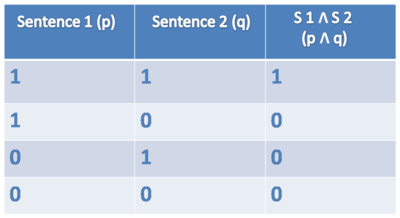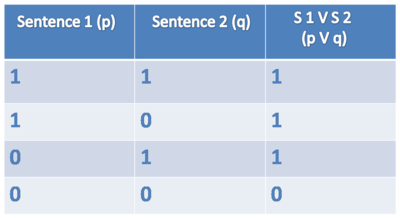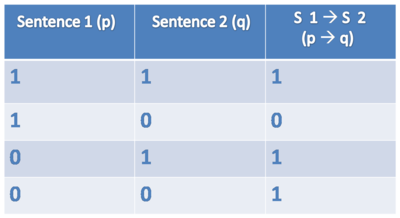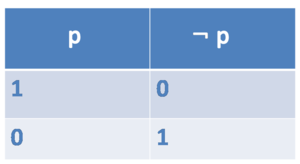Wiki-ch2: Difference between revisions
(→Models) |
(→Links) |
||
| Line 79: | Line 79: | ||
<mediaplayer>http://www.youtube.com/watch?v=ZWdltj5Mqdc</mediaplayer> | <mediaplayer>http://www.youtube.com/watch?v=ZWdltj5Mqdc</mediaplayer> | ||
= Videos with example computations = | |||
https://www.youtube.com/watch?v=K14D7VllA8M&feature=youtu.be | |||
= Links = | = Links = | ||
Revision as of 21:53, 30 April 2014
Additional Wiki pages for Chapter 2
Models
The following material is an adapted form of material created by student participants of the project e-Learning Resources for Semantics (e-LRS). Involved participants: Lisa, Marthe, Elisabeth, Isabelle.
Watch a short podcast what first-order models look like.
<mediaplayer>http://youtu.be/4a3mXelw7H4</mediaplayer>
Based on this podcast, we can define a model as follows:
- Universe: U = {LittleRedRidingHood, Grandmother, Wolf}
- Properties:
red-hood = { < x> | x wears a read hood } = { <LittleRedRidingHood> }
female = { <x> | x is female } = { <LittleRedRidingHood>, <Grandmother> }
big-mouth = { <x> | x has a big mouth } = { <Wolf> } - Relation:
grand-child-of = { <x,y> | x is y 's grandchild } = { <LittleRedRidingHood,Grandmother > }
Truth tables
The following material is an adapted form of material created by student participants of the project e-Learning Resources for Semantics (e-LRS). Involved participants: Lisa, Marthe, Elisabeth, Isabelle.
Truth tables for connectives
AND (∧)
Symbol: ∧
Sentence: Harry is a student and Snape is a teacher.
Formulae: student(harry) ∧ teacher(snape)
A conjunction p ∧ q it true if and only if p is true and q is true.
Truthtable AND
OR (∨)
Symbol: ∨
Sentence: Harry is a student or Snape is a teacher.
Formulae: student(harry) ∨ teacher(snape)
A disjunction p ∨ q is true if and only if p is true or q is true (or both).
Truthtable OR
IF/THEN (⊃, →)
Symbol: ⊃, → (Note: We use the symbol ⊃ in the textbook as it is more common in the logical literature.)
Sentence: If Harry is a student then Snape is a teacher.
Formula: student(harry) ⊃ teacher(snape)
An implication p ⊃ q is true if and only if p is false or q is true (or both).
In other words: An implication p ⊃ q is true if and only if whenever p is true, q is true as well.
Truthtable IF/THEN
NOT (¬)
Symbol: ¬
Sentence: Harry is not a student.
Formula: ¬student(harry)
A negated formula ¬p is true if and only if p is false.
Example: Only if student(harry) is false, ¬student(harry) is true.
Truthtable NOT
Truth tables for complex formulae
Truth tables are also useful to compute the truth value of complex formulae. This is shown in the following podcast, created by Lisa Günthner.
<mediaplayer>http://www.youtube.com/watch?v=ZWdltj5Mqdc</mediaplayer>
Videos with example computations
https://www.youtube.com/watch?v=K14D7VllA8M&feature=youtu.be
Links
There are short lectures by Jürgen Hanke (Virtual Linguistics Campus) related to the topics of Chapter 2:
- Predicates and their arguments
- Logical connectives
- Quantifiers ("∀" and "∃")
- Note: The video mentions the terms "restrictor" and "scope" of a quantifier but uses the conventional first-order representation of quantifiers. This means that the restrictor and the scope are linked by an implication ("&sup") in the case of a universal quantifier and by a conjunction ("∧") in the case of the existential quantifier.
So, where we write: ∀ x (φ : ψ), the traditional notation is: ∀ x (φ ⊃ ψ),
and where we write ∃ x (φ : ψ), the traditional notation is ∃ x (φ ∧ ψ) - Note: In the video, the symbol "¬" is called "the negative quantifier". This is to be seen as short hand for "¬∃"
- Note: The video mentions the terms "restrictor" and "scope" of a quantifier but uses the conventional first-order representation of quantifiers. This means that the restrictor and the scope are linked by an implication ("&sup") in the case of a universal quantifier and by a conjunction ("∧") in the case of the existential quantifier.
Back to
- the material for chapter 2
- the overview over all chapters



